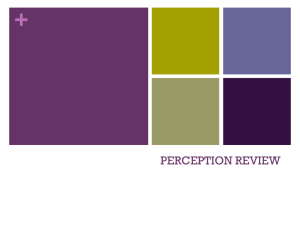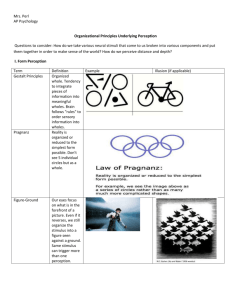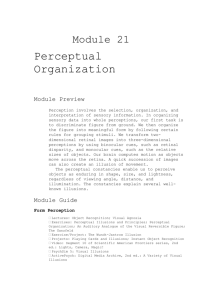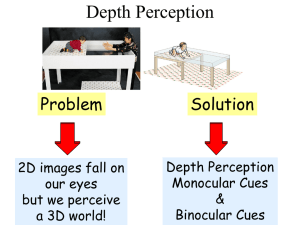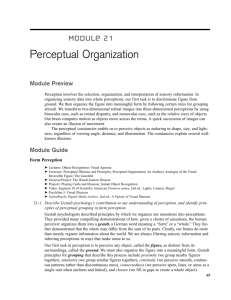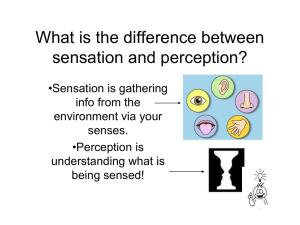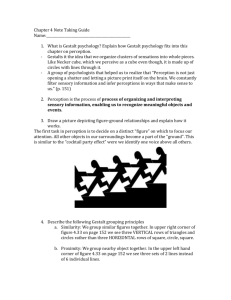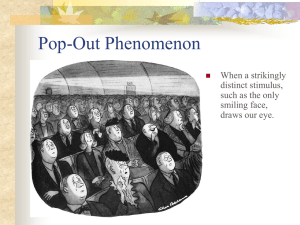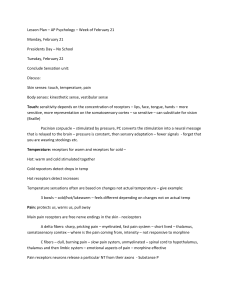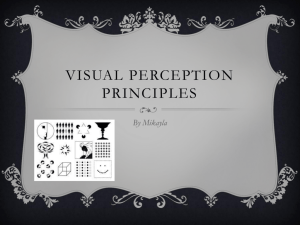Unit 6: Perception Perception: The process of organizing and
advertisement
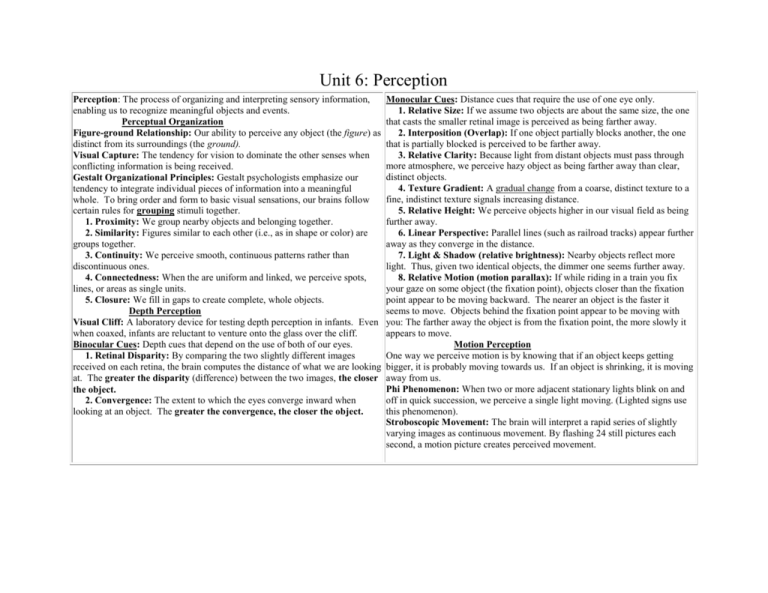
Unit 6: Perception Perception: The process of organizing and interpreting sensory information, enabling us to recognize meaningful objects and events. Perceptual Organization Figure-ground Relationship: Our ability to perceive any object (the figure) as distinct from its surroundings (the ground). Visual Capture: The tendency for vision to dominate the other senses when conflicting information is being received. Gestalt Organizational Principles: Gestalt psychologists emphasize our tendency to integrate individual pieces of information into a meaningful whole. To bring order and form to basic visual sensations, our brains follow certain rules for grouping stimuli together. 1. Proximity: We group nearby objects and belonging together. 2. Similarity: Figures similar to each other (i.e., as in shape or color) are groups together. 3. Continuity: We perceive smooth, continuous patterns rather than discontinuous ones. 4. Connectedness: When the are uniform and linked, we perceive spots, lines, or areas as single units. 5. Closure: We fill in gaps to create complete, whole objects. Depth Perception Visual Cliff: A laboratory device for testing depth perception in infants. Even when coaxed, infants are reluctant to venture onto the glass over the cliff. Binocular Cues: Depth cues that depend on the use of both of our eyes. 1. Retinal Disparity: By comparing the two slightly different images received on each retina, the brain computes the distance of what we are looking at. The greater the disparity (difference) between the two images, the closer the object. 2. Convergence: The extent to which the eyes converge inward when looking at an object. The greater the convergence, the closer the object. Monocular Cues: Distance cues that require the use of one eye only. 1. Relative Size: If we assume two objects are about the same size, the one that casts the smaller retinal image is perceived as being farther away. 2. Interposition (Overlap): If one object partially blocks another, the one that is partially blocked is perceived to be farther away. 3. Relative Clarity: Because light from distant objects must pass through more atmosphere, we perceive hazy object as being farther away than clear, distinct objects. 4. Texture Gradient: A gradual change from a coarse, distinct texture to a fine, indistinct texture signals increasing distance. 5. Relative Height: We perceive objects higher in our visual field as being further away. 6. Linear Perspective: Parallel lines (such as railroad tracks) appear further away as they converge in the distance. 7. Light & Shadow (relative brightness): Nearby objects reflect more light. Thus, given two identical objects, the dimmer one seems further away. 8. Relative Motion (motion parallax): If while riding in a train you fix your gaze on some object (the fixation point), objects closer than the fixation point appear to be moving backward. The nearer an object is the faster it seems to move. Objects behind the fixation point appear to be moving with you: The farther away the object is from the fixation point, the more slowly it appears to move. Motion Perception One way we perceive motion is by knowing that if an object keeps getting bigger, it is probably moving towards us. If an object is shrinking, it is moving away from us. Phi Phenomenon: When two or more adjacent stationary lights blink on and off in quick succession, we perceive a single light moving. (Lighted signs use this phenomenon). Stroboscopic Movement: The brain will interpret a rapid series of slightly varying images as continuous movement. By flashing 24 still pictures each second, a motion picture creates perceived movement. Perceptual Constancies Perceiving objects as unchanging (having constant lightness, color, shape, and size) even when our retinal images of them change. For example: Shape Constancy: We perceive the form of familiar objects as constant even when our retinal images of them change. Size Constancy: We perceive familiar objects to maintain a constant size even when their distance from us changes. Lightness Constancy: We perceive an object as having a constant lightness even when its illumination varies. Some Visual Illusions The Ponzo Illusion (in two forms) The Ames Room Muller-Lyer Illusion **Please see your textbook for explanations of these illusions. Sensory Deprivation People blind from birth, who later have their vision restored, can distinguish figure-ground relationships, can sense colors, but have great difficulty recognizing objects that they were familiar with by touch. Similarly, Blakemore & Cooper found that kittens whose vision was restricted to only seeing vertical lines during a critical period of development, later could not see horizontal lines. Perceptual Adaptation: In vision, the ability to adjust to an artificially displaced or even inverted visual field. Perceptual Set: A mental predisposition to perceive one thing and not another (e.g., seeing the Lock Ness Monster instead of a piece of driftwood because of your beliefs). Context Effects: Any given stimulus may trigger radically different perceptions depending on the surrounding environment or circumstances. Culture may have a great impact on context and perception. Human Factors Psychology: A branch of psychology that explores how people and machines interact and how machines and physical environments can be adapted to human behaviors. Extrasensory Perception (ESP) The controversial claim that perception can occur apart from sensory input. Telepathy: Mind to mind communication Clairvoyance: The sensing of remote events that are presently occuring. Precognition: The sensing of future events. Telekinesis (psychokinesis): Ability to affect objects with the power of the mind. Parapsychologists: Psychologists who study paranormal occurrences, including claims of ESP.
